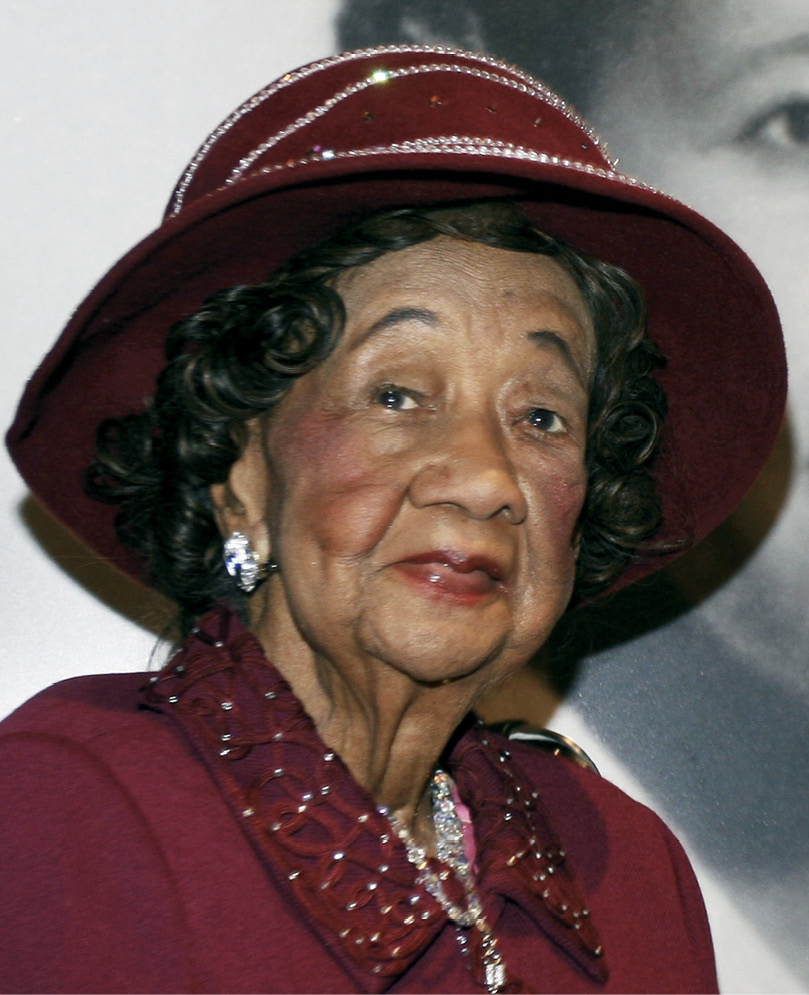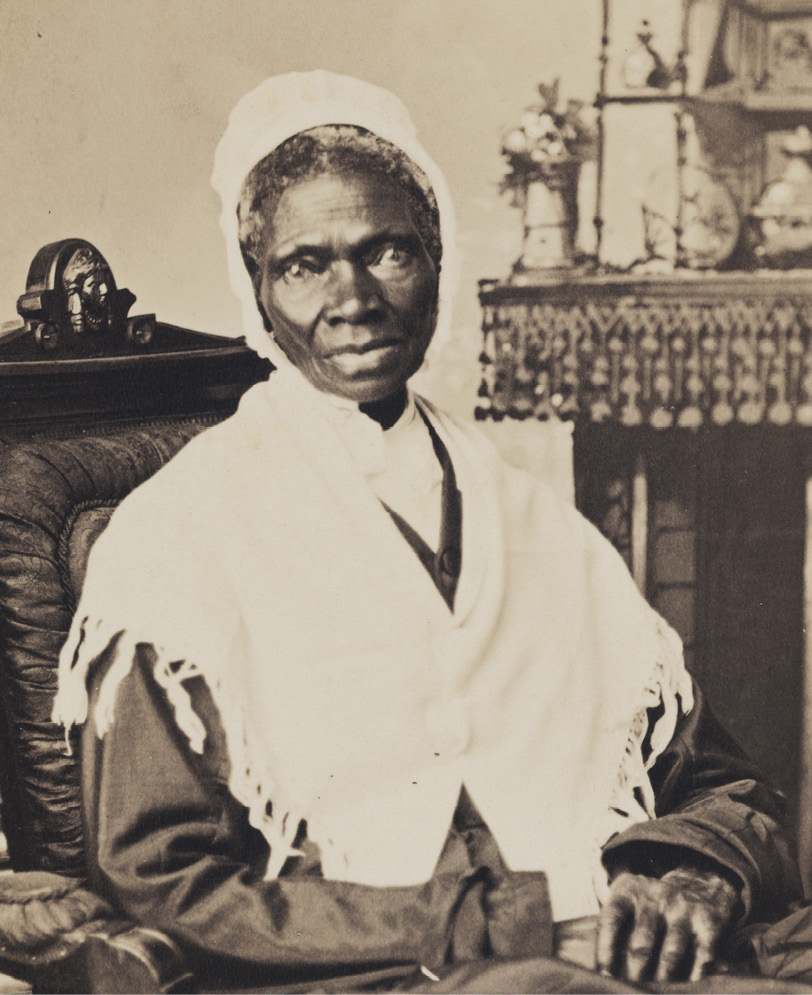Dorothy Height and Sojourner Truth

DOROTHY HEIGHT

SOJOURNER TRUTH
Hillary
In her memoir, Open Wide the Freedom Gates, Dr. Dorothy Irene Height, a legend of the civil rights movement, declared: “I am the product of many whose lives have touched mine, from the famous, distinguished, and powerful to the little known and the poor.”
If you live in America and vote, whether you know it or not, Dorothy Height has touched your life. I first met Miss Height—that’s what we always called her—back when I was just out of law school and working for another fiercely courageous woman, Marian Wright Edelman, at the Children’s Defense Fund. Miss Height was elegant but with no airs; brilliant without a trace of arrogance; passionate, but never overheated. And though she spent much of her later years sitting down, she was never sitting still. Because when Dorothy Height set her mind to something, there was no stopping her.
Miss Height grew up outside Pittsburgh and attended integrated schools. She won a national oratory contest in high school that provided a college scholarship, but when she arrived at Barnard College in 1929, she was turned away and informed that the college had already admitted two black students—apparently its yearly quota. So she headed downtown and enrolled at New York University, where she received her bachelor’s degree and a master’s in educational psychology.
After college, she went to work for the YWCA and joined the National Council of Negro Women, beginning a career of fighting for civil rights and equality for black Americans and women. She served as the Council’s president for forty years, from 1957 to 1997. Alongside the “Big Six” of the civil rights movement, which included legends like Dr. Martin Luther King Jr. and John Lewis, Miss Height was called “the unheralded seventh.” She was the only woman given that distinction. Her activism attracted the notice of Eleanor Roosevelt, Dwight Eisenhower, Lyndon Johnson, and many others who sought her out for advice. She was a nonpartisan adviser to presidents of both parties. She received the Presidential Medal of Freedom from my husband in 1994, and the Congressional Gold Medal from President George W. Bush in 2004.
When I was in the Senate, Miss Height and a group of other civil rights leaders—including Dr. C. Delores Tucker and E. Faye Williams of the National Congress of Black Women—came to me and Congresswoman Sheila Jackson Lee of Texas. They argued that it was past time for the U.S. Capitol Building to have a statue of the pioneering black suffragist Sojourner Truth, right alongside other national heroes.
Sojourner Truth, then named Isabella Baumfree, was born into slavery in New York around 1797. She escaped with her infant daughter, Sophia, in 1827—a year before New York’s emancipation law went into effect. She later used the new law to sue for the return of her five-year-old son, Peter, who had been illegally sold to a slaveholder in Alabama. She is considered the first black woman to win such a case.
In 1843, she became a Methodist and took the name Sojourner Truth, explaining to her friends: “The Spirit calls me, and I must go.” She never learned to read or write, but she traveled the country, preaching in favor of the abolition of slavery. Her memoir, The Narrative of Sojourner Truth: A Northern Slave, was published in 1850, the same year she spoke at the first National Women’s Rights Convention in Worcester, Massachusetts. In 1851, she attended the Ohio Women’s Rights Convention in Akron. In a crowded church, she delivered her famous extemporaneous speech on women’s rights, “Ain’t I a Woman.” From her towering height (she was nearly six feet tall), she responded to the male speakers who had argued that women were inferior to men and too weak to be entrusted with the vote. “If the first woman God ever made was strong enough to turn the world upside down all alone, these women together ought to be able to turn it back and get it right side up again!” she declared in her deep, booming voice. “And now they is asking to do it, the men better let them.”
Her speech became an immediate sensation, prompting competing stories about how she presented herself and even what she had said. When a heckler at a speech in 1858 questioned whether she was, in fact, a woman, she answered by opening her blouse to reveal her breasts.
During the Civil War, she helped recruit black soldiers for the Union Army and worked with the National Freedman’s Relief Association in Washington, D.C. In 1864, she met with President Lincoln at the White House. While in Washington, she helped force desegregation of local streetcars by riding them. When a conductor tried to stop her from boarding, she had him arrested, took him to court, and won her case, nearly a century before Claudette Colvin and Rosa Parks refused to give up their seats on the bus.
After the war, she met with President Ulysses S. Grant. She gathered thousands of signatures on a petition to provide land grants to help former slaves escape poverty and build new lives. She campaigned for Grant’s reelection, and in 1872, she even tried to vote, though she was turned away. Sojourner kept speaking out about abolition, women’s rights, prison reform, and capital punishment until her death in 1883.
With a record like this, you might not think it would be controversial to add Sojourner Truth to the U.S. Capitol’s Emancipation Hall. But, as it turns out, it’s hard to get Congress to do just about anything. We faced one delay after another. Lesser women would have gotten discouraged, settled for less, or just given up. That wasn’t Miss Height’s way. She just kept pushing, calling, and writing.
“That man over there says that women need to be helped into carriages, and lifted over ditches, and to have the best place everywhere. Nobody ever helps me into carriages, or over mud-puddles, or gives me any best place! And ain’t I a woman? Look at me! Look at my arm! I have ploughed and planted, and gathered into barns, and no man could head me! And ain’t I a woman? I could work as much and eat as much as a man—when I could get it—and bear the lash as well! And ain’t I a woman? I have borne five children, and seen most all sold off to slavery, and when I cried out with my mother’s grief, none but Jesus heard me! And ain’t I a woman?”
—SOJOURNER TRUTH
It took us years, but we finally got Sojourner’s statue put up. And on April 28, 2009, we gathered in the Capitol Visitor Center for the unveiling. The celebrated actress Cicely Tyson recited “Ain’t I a Woman.”
With her very presence, Cicely, like Sojourner, embodied the indivisibility of women’s rights and civil rights. You couldn’t be for one and not the other. You couldn’t give the vote to just some women. Or just some black Americans. Our democracy belongs to all of us, and it needs to protect and serve every citizen. We all are freer when every one of us is free. We all have more opportunity when everyone has opportunity. That was Sojourner Truth’s mission. It was Dorothy Height’s mission. And today it must remain our mission.